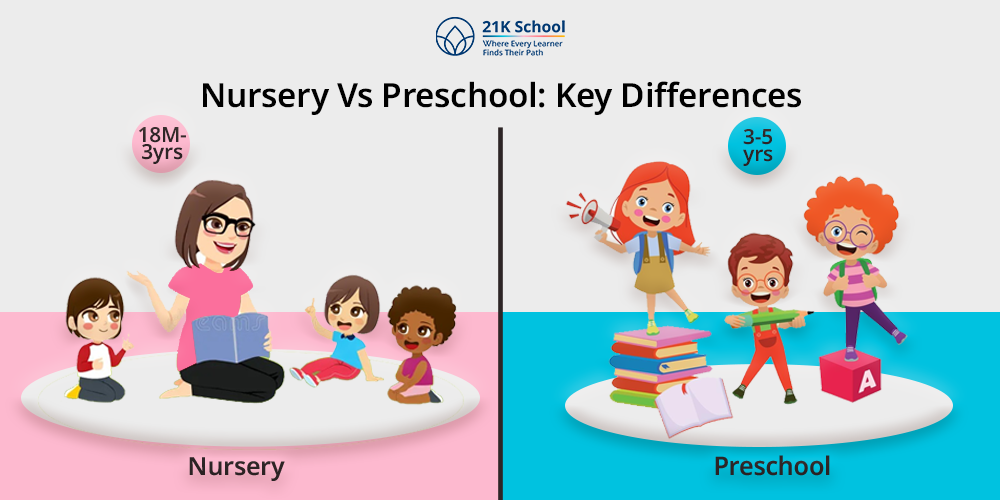
Choosing the right early education option is one of the first big decisions parents face. Among the various choices, nursery and preschool often seem similar, but they serve different purposes in a child’s early development.
Both offer a safe and stimulating environment, but they differ in structure, approach, and age criteria. Knowing the differences can help you make a confident and informed choice for your child’s future.
Table of Contents
What Is a Nursery School?
A nursery school is typically designed for toddlers between 18 months and 3 years old. At this tender age, children are beginning to explore the world around them, but still need close care and supervision.
Nurseries focus on basic care, comfort, and early social interaction. Activities are informal and play-based, helping toddlers develop essential motor skills and social confidence in a gentle, nurturing environment.
Children in nursery school usually enjoy activities like rhymes, sensory play, puppet shows, and free movement, all while being looked after by attentive caregivers in a calm and homely setup.
Also read: Activities for Nursery Kids
What Is a Preschool Program?
Preschools cater to children aged 3 to 5 years, preparing them for the more structured environment of kindergarten or primary school. The focus shifts from just care and play to early learning, skill-building, and school readiness.
Preschool introduces structured routines, early literacy and numeracy, creative thinking , and group-based learning. The learning is still fun and playful, but guided by a clear curriculum designed for holistic education .
Children learn to recognise letters and numbers, follow instructions, solve simple problems, and work with peers, laying the foundation for a successful transition to formal education .
Explore more detailed information about importance of preschool education.
Key Differences Between Preschool and Nursery
Although both serve as stepping stones in early childhood education, preschool and nursery differ significantly in their purpose, curriculum, and daily experience:
| Aspect | Nursery | Preschool |
| Age Group | 18 months – 3 years | 3 – 5 years |
| Main Focus | Basic care, emotional comfort, and play | School readiness, early learning |
| Curriculum | Informal, play-based | Structured, skill-building |
| Learning Approach | Sensory and social exploration | Guided academics through play |
| Teacher Training | Basic child care training | Certified early education teachers |
| Daily Routine | Flexible and short | Structured and longer |
| Environment | Homely, daycare-like setting | School-like with learning corners |
| School Readiness | Limited, more social-emotional | Strong focus on academic and emotional prep |
1. Age Criteria
Nursery usually accepts children between 18 months to 3 years old.
Preschool is meant for children aged 3 to 5 years, just before they start kindergarten.
These age differences impact the design of activities, the level of independence expected, and the type of learning offered in each setting.
2. Purpose and Focus
Nursery focuses on emotional security, introducing toddlers to life outside the home, safely and playfully. It supports social comfort, trust-building, and simple communication.
Preschool, on the other hand, is about preparing children for school. It emphasises learning, cognitive development, and self-help skills, giving kids the confidence and competence they need in a classroom setting.
3. Curriculum and Learning Approach
The nursery curriculum is often unstructured and focuses on sensory play, movement, and basic routines like eating and toilet training. Activities are exploratory and guided more by comfort than goals.
In contrast, preschool follows a structured curriculum. It includes alphabet and number recognition, simple math, early science concepts, art, storytelling, and more. While play is still central, learning outcomes are carefully integrated.
4. Teacher Qualifications
Nursery caregivers usually have basic training in childcare and first aid, with a strong emphasis on patience, safety, and emotional support.
Preschool teachers are often certified early childhood educators, trained to introduce academic and social concepts in developmentally appropriate ways. Their knowledge ensures each activity supports growth in a targeted area.
5. Daily Schedule and Duration
The nursery schedule is typically short and flexible, often lasting 2 to 3 hours. It includes free play, snack time, story sessions, and naps, ensuring toddlers feel secure and relaxed.
Preschools follow a more structured daily routine, usually lasting 3 to 4 hours or even a full day in some cases. It includes group learning, individual tasks, music, outdoor play, and creative projects, building focus and discipline.
6. Learning Environment
Nurseries offer a daycare-like, cosy environment, often filled with soft toys, mats, and free space to move around. The goal is to simulate a second home.
Preschools resemble mini-classrooms, with child-sized tables, learning boards, charts, and activity zones. This helps children get accustomed to school settings, making the transition smoother when formal education begins.
7. Readiness for School
Nurseries introduce basic routines and social interactions, but don’t focus on academics or school-like discipline. They serve as an emotional and social starting point.
Preschools actively prepare children for formal school by teaching foundational academic and self-regulation skills. Children learn how to listen to instructions, complete tasks, and interact in a group setting.
Also Read, 10 Types of Preschools in India.
Conclusion: Making the Right Choice For Your Child
Whether you choose nursery or preschool, the most important thing is that your child feels safe, supported, and excited to explore.
Nurseries help toddlers take their first steps into the world with gentle care and joyful play. Preschools take it further, shaping little learners into curious, confident students ready for school.
By understanding the difference between preschool and nursery, you’re already taking the first step in giving your child a strong start.


